Share via:
Bradley, Will H., illustrator and artist, 1968-1962.
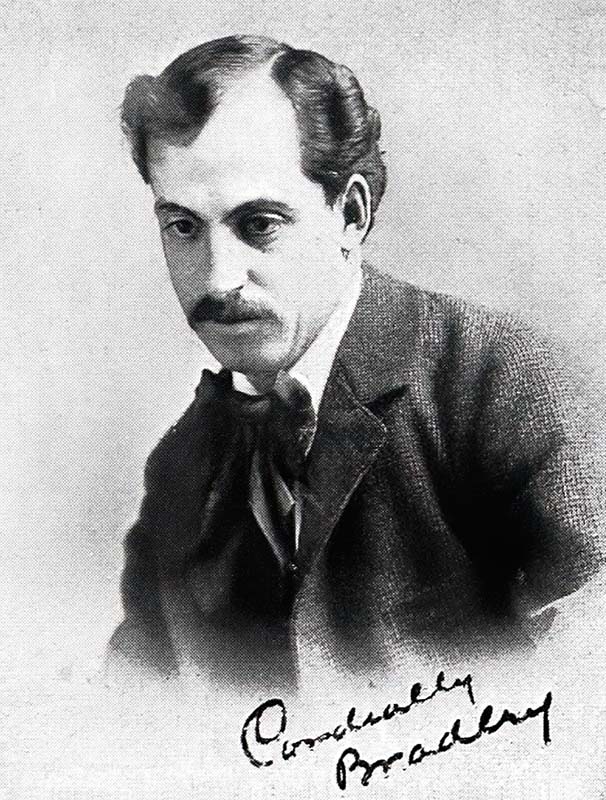
During the last years of the nineteenth century many respected artists turned to the creation of posters, pottery and glassware, elaborate needlework compositions and patterns for wallpapers and draperies. The current enthusiasm for handcraftsmanship and Art Nouveau, the style closely identified with the Arts and Crafts Movement, has encouraged many to turn to this earlier period, the 1890’s, for artistic inspiration.
Contemporary interest in the fin de siecle has led to the discovery of many artist-craftsmen whose work, out of favor for decades, has been neglected. Among those was Will Bradley, an American decorative illustrator and artisan who was esteemed in his own day as
… a craftsman, in the best sense of this much-abused word; one who seeks to beautify the essentially utilitarian; one of that sturdy band of artists who, walking in the humble path of their own choosing, make the hardest kind of a fight against bad traditions and the prevailing custom and prejudices of mere commercialism; and one of those who succeed in giving the charm and dignity of art to objects of common use.
Born in Boston, Massachusetts, in 1868, William Henry Bradley was fascinated by type, printing, and illustration as a child. When he and his mother moved to Ishpeming, Michigan, after his father’s death in 1879, he found a job as a printer’s devil and later was foreman of the local newspaper. He composed with type at work, while in his spare time he earned extra money by designing posters. In 1886 he moved to Chicago to begin his career as an artist. He soon found his forte as a pen-and-ink illustrator, and by 1890 his work was appearing in Frank Leslie’s Illustrated Newspaper and the Chicago trade journal, The Inland Printer.
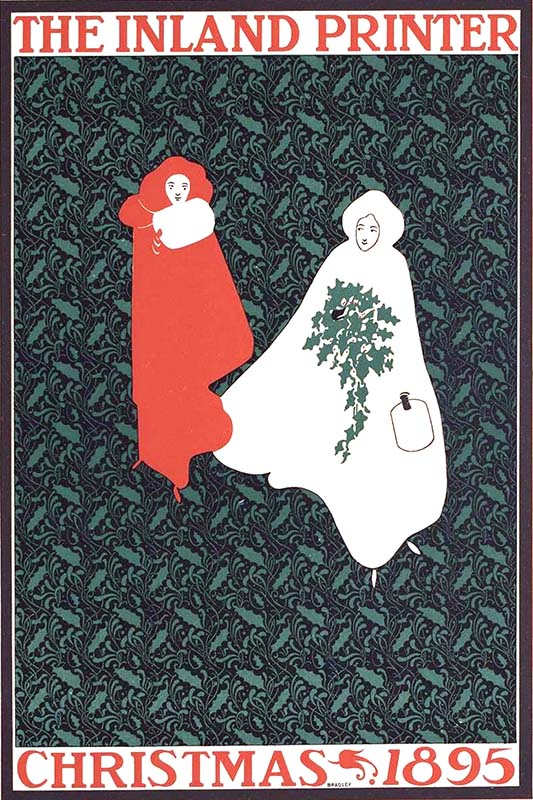
Will H. Bradley did not have enough money to attend art classes during those early years in Chicago, and, instead, received his instruction from contemporary magazines, libraries, and local bibliophiles. Like many other self-taught artists of his day, he was quite aware of the latest developments in the art world, here and abroad. He must have read English and American essays on Japanese art and certainly observed how Eastern concepts of design were being assimilated into contemporary illustration and ornament.
He studied British theories of art and decoration, such as those formulated by Owen Jones and Christopher Dresser. The Englishman who had the greatest impact upon Bradley and many of his contemporaries, however, was William Morris. Morris popularized the idea that the Arts and Crafts Movement had a mission. All the arts, from painting to furniture design, were to bring joy to the craftsman as he produced objects that, in turn, would make everyday life more beautiful.
His firm, Morris and Company, a model for other craftsmen, created and sold wallpapers, fabrics, metalwork, furniture, and stained glass. Morris himself founded the Kelmscott Press, where he designed and printed many richly decorated books. The work of Morris and his followers became identified with a particular style of design; decoration was derived from nature, but was simplified. usually symmetrical, and often interlaced with curving lines.
Will H. Bradley was also aware of another emerging English art movement that had originated from ideas proposed by Oscar Wilde. This school embraced no lofty moral tenets, but revered art for art’s sake. The English school of design associated with this philosophy was related to an art movement that was developing on the Continent during die early 1890’s; asymmetrical compositions, strong surface patterns, and dominating curvilinear rhythms were hallmarks of both British and Continental Art Nouveau.
In his early illustrations and ornaments, Bradley acknowledged his debt to the work of contemporary American draftsmen, to members of the English Arts and Crafts Movement (including Herbert Horne, Walter Crane, and William Morris), as well as his admiration for Japanese art. Although he realized a distinct sense of design by combining, as early as 1891, asymmetrical, curvilinear ornament with contrasting black and white areas, it was not until 1894 that his work dramatically matured into a thoroughgoing Art Nouveau style in a series of covers for The Inland Printer and several posters for a Chicago magazine, The Chap-Book).
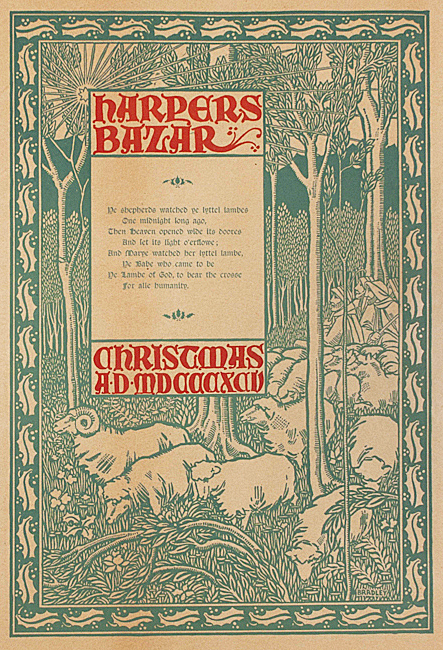
The catalyst, Aubrey Beardsley’s illustrations for Le Morte d’Arthur and Salome, inspired Bradley to achieve a new unity of design through increasingly expansive, curving lines and a subtle balance of bold, asymmetrical surface patterns and shapes. It would be most unnatural in a person so young and impressionable not to show evidence of numerous outside forces; at the same time, Bradley went beyond them and created something quite his own.
Bradley’s posters and cover designs commissioned in 1894 marked the beginning of Art Nouveau in America, and along with the posters that Edward Penfield executed for Harper’s Magazine, initiated die poster craze in this country. The work of countless Bradley imitators appeared at the newsstands, book stores, and on billboards, and provoked considerable comment from the startled, yet often enthusiastic public.
Some who admired the poster as an art form marveled “at the growth and vitality of this class of design,” while others, overwhelmed by the surfeit of placards, predicted its imminent demise. Bradley, who did not overestimate the importance of the poster as a new form, believed that it had a place in his role as an artist: “My constant efforts have been to make better and more refined that art which walks hand in hand with business.”
His goal to beautify the utilitarian prompted him to leave Chicago at the end of 1894 for Springfield, Massachusetts. He planned to set up his own press, modeled after Morris’s Kelmscott Press, where he could print advertising booklets and publish his own periodical. Much of his first year in Springfield, however, was spent completing commissions, including some of his finest Art Nouveau posters and covers for The Chap-Book, The Chicago Sunday Tribune, The Echo and Harper’s Bazar.
Among his most outstanding commercial work from this period were his book illustrations, influenced by the black and white designs of Aubrey Beardsley, Charles Ricketts, and Laurence Housman. In Richard Blackmore’s Fringilla, Bradley achieved a unity of type and illustration that prompted a critic for The Book Buyer to see Bradley as “the pioneer … the head of an American movement, similar to that which is taking place in England, France, and Germany, toward beautiful artistic books.”
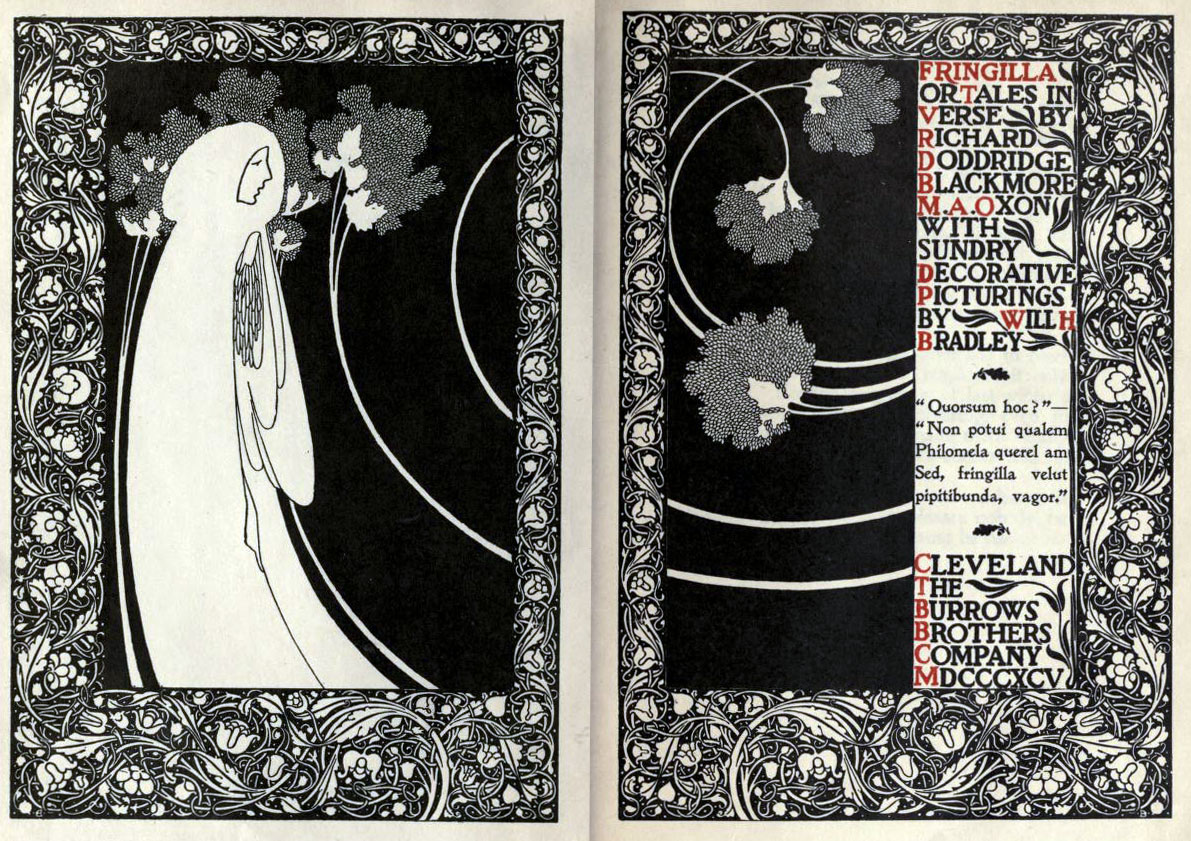
Shortly after Fringilla was published Bradley established the Wayside Press and by May 1896, the first issue of Bradley: His Book appeared at the newsstands (prospectus, Plate 27). An art and literary magazine like many of the bibelots which proliferated during the 1890’s, Bradley: His Book was distinguished by the outstanding decorative illustrations that enriched the text and advertisements. Bradley himself wrote several short stories for the magazine, again following the example set by William Morris, who once said, “If a chap can’t compose an epic poem while he’s weaving tapestry he had better shut up; he’ll never do any good at all.”
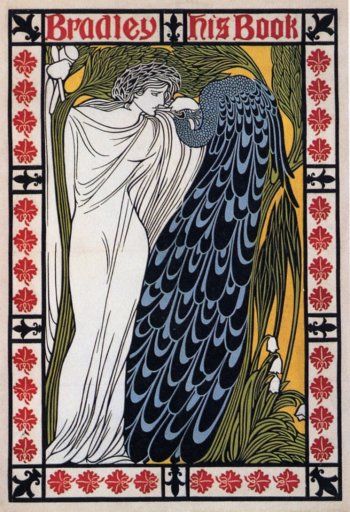
As Bradley: His Book became both a critical and financial success, Bradley was encouraged to sponsor his own arts and crafts movement by promoting in his magazine good art and design in the gallery, the book, the advertisement and the home. He planned to report on the latest developments in the fine arts … and “Architecture, with special reference to the planning of interiors. …” The graphic arts were to be represented by the discussion of “Book Illustration, in all its new developments….”
He considered applied art, decoration and design for the home to be part of the crafts revival, and planned to include articles on embroidery and china painting, and “suggestions for the artistic arrangement of the home, and designs for screens, portieres, settles, cozy-corners, window-seats, etc.” To guide the amateur he promised to provide “full-sized working patterns of novel and pleasing designs” (Plates 60-61). In his Springfield studio he also intended to produce “pictures, books, tapestries, and artistic effects generally,” along with “wallpapers and all kinds of mural decorations, including fabrics.”
Although many of these plans were never realized, the Wayside Press produced much outstanding work from 1896 until! 1898. Bradley arranged, illustrated, and printed numerous books for his own sale and for such publishers as Way and Williams and the English firm, John Lane. Advertisements printed at the Wayside Press were recognized by trade journals as important and influential examples of commercial design’. Bradley, however, exerted his greatest influence on the printing world.
Throughout his life he had been intrigued by type: as early as 1891 he had designed several type faces for The Inland Printer, and in 1895 the American Type Pounders bought the rights to the lettering he created for one of his Inland Printer covers. Bradley drew upon his study of colonial American and eighteenth-century English printing and introduced in his work at the Wayside Press, Caslon Roman and italic type, which he combined with woodcut initials and ornaments. The trade journals quickly adopted this scheme, and one critic observed, … there is no mistaking the immediate importance and value of Mr. Bradley’s work. It is bound to have an enormous influence upon all printing of the future. His aims and efforts are as far above those of the established printing trade as were the aims and ideals of William Morris.
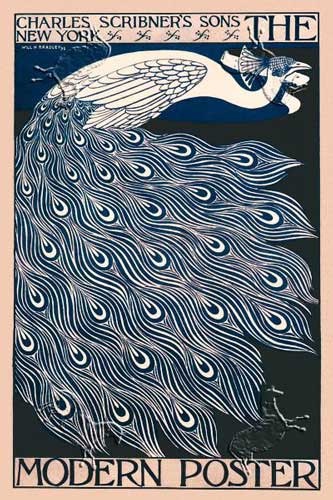
A critical success, the Wayside Press was disbanded at the end of 1898 when Bradley found his health threatened by the demands of his job. He sold his press to the University Press at Cambridge, Massachusetts, and went to work for this firm to help meet his financial obligations. For the next two years he continued to arrange and illustrate brochures and books, and brought the same kind of acclaim to his new employer that had once been showered upon his own press.
Toward the end of his tenure at the Cambridge firm he began to accept freelance commissions, In 1899 he designed a new layout for The Bookman and Harper’s Weekly, and at the turn of the century, he was asked to arrange a new editorial prospectus for The Ladies’ Home Journal. Although this project was never executed it did introduce Bradley to the editor, Edward Bok, who commissioned the artist, after he had left the University Press, to create for the Journal a series of home interiors to be called “The Bradley House”. His continuing interest in the English Arts and Crafts Movement was apparent in these designs where the pictorial, elegant and whimsically imaginative qualities of his work often set Bradley apart from his American contemporaries Frank Lloyd Wright and Gustav Stickley and linked him more closely to the English craftsmen and architects M. H. Baillie Scott and C. F. A Voysey.
During this period Bradley resumed his career as an illustrator, and in 1900 and 1901 he completed a series of covers for Collier‘s Magazine. These and the illustrations which he designed for the two children’s stories that he wrote, “Castle Perilous” and Peter Poodle, Toymaker to the King, reveal dramatic changes in his drawing style. Gone are the rhythmical Art Nouveau curves, the dramatic, asymmetrical juxtaposition of patterns, replaced by more static and contained compositions.
Although in much of his late work Bradley reflected a trend in American illustration toward the pictorial by introducing three-dimensionality and modeling into his Collier’s covers, he continued to emphasize the decorative qualities of each design through strong contour outlines and symmetrical compositions, and like Maxfield Parrish preferred ornamental frontal and profile caricature figures. After the turn of the century Bradley also continued to draw his woodcut ornaments, a bold and angular style that had interested him since his Wayside Press days.
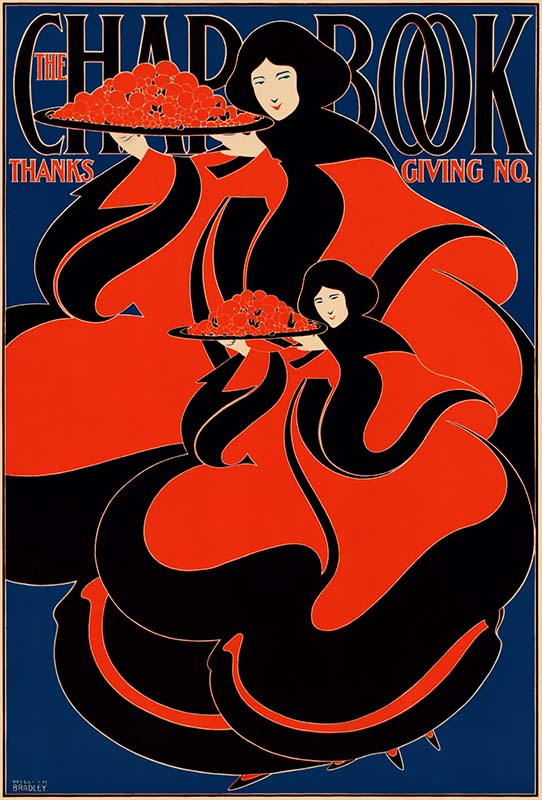
Another commission from this period was an advertising campaign that he undertook for the American Type Founders. For this firm in 1904 and 1905 Bradley wrote, arranged, and illustrated a series of twelve monthly magazines, The American Chap-Book. In these little booklets Bradley continued to espouse the cause which had concerned him most of his career, to merge art with business, by advising businessmen how to design effective advertisements with American Type Founders type and ornaments.
Once again the critics received Bradley’s work with praise: “It is safe to predict that this is really a remarkable little publication and will in the future take its proper place as a distinct contribution to the subject of good typography.” It is interesting to note that Bradley was still studying the work of his English contemporaries. One of the series of ornaments which Bradley designed and introduced in The American Chap-Book, the Chap-Book Cuts (used as decorations in the introduction and autobiographical pages of the present edition), were partially derived from woodcuts devised by Joseph Crawhall in the late 1880’s.
Bradley’s interest in type design and layout, encouraged by his work for the American Type Founders, demanded more and more of his attention, and by 1907, when he became art editor of Collier’s Magazine, his career as an artist essentially had come to a close. From 1910-1915 he was simultaneously art editor of Good Housekeeping, Metropolitan, Success, Pearson’s, and National Post. In 1915 he was art supervisor for a series of motion pictures financed by William Randolph Hearst, and from 1918 to 1920 he wrote and directed his own picture, Moongold.
During the 1920’s he was back working for Hearst as art supervisor for all his publications. This busy career left little time for his own art work. Although Bradley ran an art service in New York from 1912—1914, and wrote and illustrated another children’s story, Wonderbox Stories, in 1916 (Plate 88), this work could not match the originality of the designs of his youth; instead, he had chosen to direct his energy and creativity to the printing world, to bring gaiety and life to the printed page.
By the time Art Nouveau was being rediscovered by the present generation, and arts and. crafts had become a fashionable pursuit, Will H. Bradley himself was scarcely aware of his early achievements. He was somewhat surprised by the recognition he received during the 1950’s until his death in 1962. In California the Bounce and Coffin Club commended his fine work as a printer and draftsman and the Huntington Library presented an exhibition of his illustrations, books, advertisements, and typography. The American Type Founders honored their long-standing association by commissioning Bradley to design a series of type ornaments, while Strathmore Papers, one of his first customers at the Wayside Press, asked him to decorate a selection of paper samples for an advertising campaign.
Clarence P. Hornung & Roberta W. Wong, NY 1973
